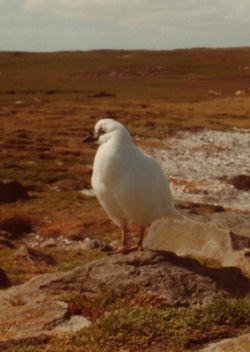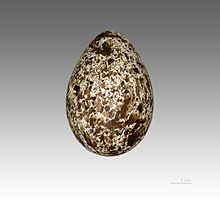- Black-faced Sheathbill
-
Black-faced Sheathbill Black-faced Sheathbill, Chionis minor Conservation status Scientific classification Kingdom: Animalia Phylum: Chordata Class: Aves Order: Charadriiformes Family: Chionididae Genus: Chionis Species: C. minor Binomial name Chionis minor
Hartlaub, 1841The Black-faced Sheathbill (Chionis minor), also known as the Lesser Sheathbill or Paddy bird, is one of only two species of sheathbills, aberrant shorebirds which are terrestrial scavengers of subantarctic islands.
Contents
Description
Dumpy, short-necked, pigeon-like birds with white plumage, black bills, caruncles and facial skin. This species measures 38–41 cm (15–16 in) in length, 74–79 cm (29–31 in) in wingspan and weighs 460–730 g (1.0–1.6 lb), with males being slightly larger than females.[1]
Distribution
Restricted to subantarctic islands in the southern Indian Ocean: the South African territory of the Prince Edward Islands, the French territories of the Crozet Islands and Kerguelen Islands, and the Australian territory of Heard Island. The race C. m. nasicornis is endemic to Heard Island, while the race C. m. marionesis is endemic to the Prince Edward Islands.
Habitat
Coastlines and intertidal zones of subantarctic islands, especially around seabird and seal colonies, as well as the vicinity of human habitation.
Food
Sheathbills are opportunistic omnivores, predators and scavengers, feeding on strandline debris, algae and other vegetation, as well as on invertebrates, fish, seabird eggs and chicks, seal milk, blood, placentas, carrion, faeces, rodents and human refuse.
Voice
Loud, high-pitched, strident and staccato calls.
Breeding
Nests in crevices, caves and under boulders on untidy piles of vegetation and debris from seabird and seal colonies. Clutch usually 2-3 creamy-white eggs, blotched or speckled brown. Incubation period c.30 days. Young semi-precocial and nidicolous; fledging c.50 days after hatching; breeding at 3–5 years.
Conservation
At risk from scavenging toxic wastes and from introduced predators such as feral cats, but large, scattered range with no evidence of significant overall population decline leads to conservation status assessment of Least Concern.
References
- ^ CRC Handbook of Avian Body Masses by John B. Dunning Jr. (Editor). CRC Press (1992), ISBN 978-0849342585.
- BirdLife International. (2006). Species factsheet: Chionis minor. Downloaded from http://www.birdlife.org on 11 February 2007
- Marchant, S.; Higgins, P.J.; & Davies, J.N. (eds). (1994). Handbook of Australian, New Zealand and Antarctic Birds. Volume 2: Raptors to Lapwings. Oxford University Press: Melbourne. ISBN 0-19-553069-1
- National Photographic Index of Australian Wildlife. (1987). The Shorebirds of Australia. Angus & Robertson: Sydney. ISBN 0-207-15348-5
Categories:- IUCN Red List least concern species
- Birds of Australia
- Antarctic birds
- Chionidi
- Fauna of the Kerguelen Islands
- Animals described in 1841
- Fauna of the Crozet Islands
- Fauna of the Prince Edward Islands
- Fauna of Heard Island and McDonald Islands
Wikimedia Foundation. 2010.



